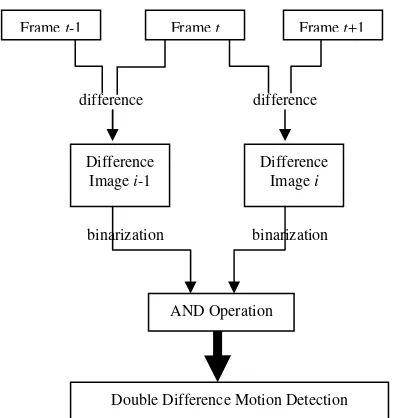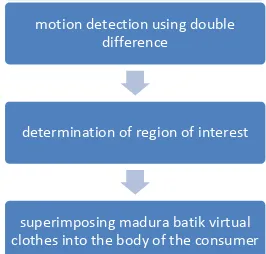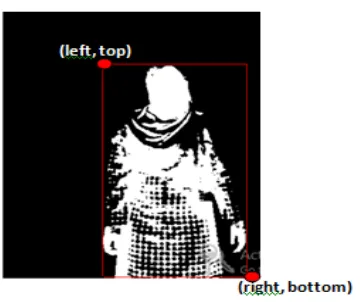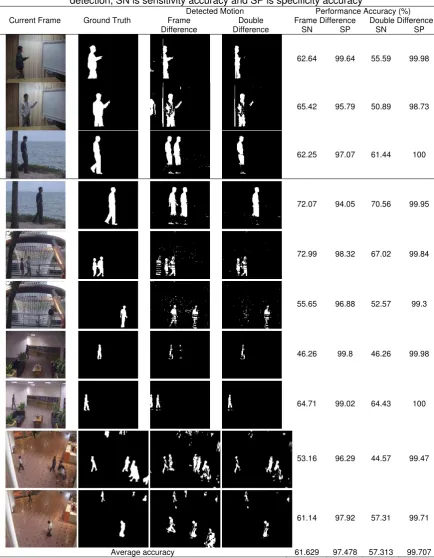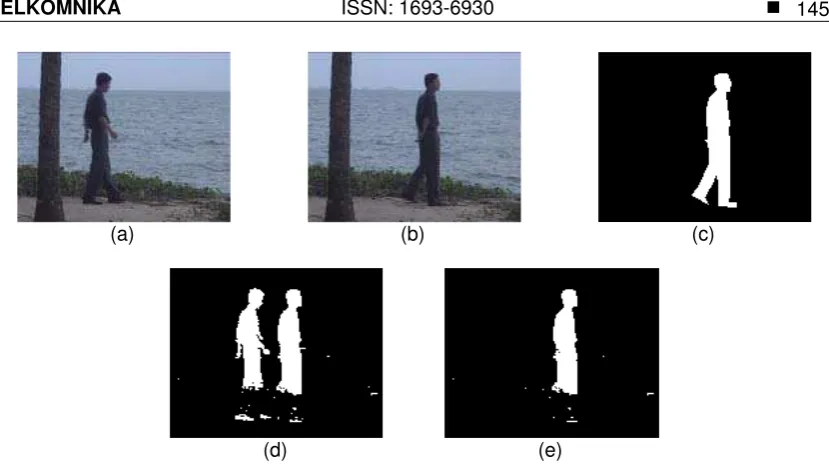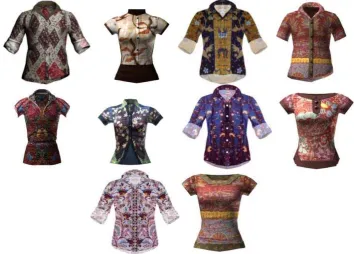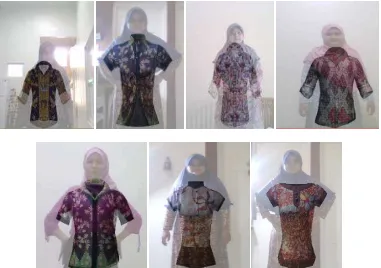DOI: 10.12928/TELKOMNIKA.v13i4.2236 1446
Double Difference Motion Detection and Its Application
for Madura Batik Virtual Fitting Room
Rima Triwahyuningrum*, Indah Agustien Siradjuddin, Yonathan Fery Hendrawan, Arik Kurniawati, Ari Kusumaningsih
Informatics Department, University of Trunojoyo Madura, Telangraya Street, Kamal, Madura *Corresponding author, email: [email protected]
Abstract
Madura Batik Virtual Fitting Room using double difference algorithms motion detection is proposed in this research. This virtual fitting room consists of three main stages, i.e. motion detection, determination of the region of interest of the detected motion, superimposed the virtual clothes into the region of interest. The double difference algorithm is used for the motion detection stage, since in this algorithm, the empty frame as the reference frame is not required. The double difference algorithm uses the previous and next frame to detect the motion in the current frame. Perception Test Images Sequences Dataset are used as the data of the experiment to measure the performance accuracy of this algorithm before the algorithm is used for the Madura batik virtual fitting room. The accuracy is 57.31%, 99.71%, and 78.52% for the sensitivity, specificity, and balanced accuracy, respectively. The build Madura batik virtual fitting room in this research can be used as the added feature of the Madura batik online stores, hence the consumer is able to see whether the clothes is fitted to them or not, and this virtual fitting room is also can be used as the promotion of Madura batik broadly.
Keywords: Motion Detection, Double Difference, Augmented Reality, Virtual Fitting Room
Copyright © 2015 Universitas Ahmad Dahlan. All rights reserved.
1. Introduction
Motion detection is an important stage in many applications, especially object tracking application. The more accurate of motion detection, then the accuracy of the object tracking will increase. The motion detection and object tracking can be used in many applications, for instance, navigation, gait recognition, surveillance system, etc. Therefore, many research focus on the motion detection algorithm [1-5].
This research proposes motion detection algorithm for Madura Batik Virtual fitting room. The Building of Madura Batik virtual fitting room is proposed in this research since currently, a home industry of Madura batik is growth increasingly. The growth is caused by the existence of Suramadu Bridge. In term of Madura batik, the Suramadu Bridge gives two main benefits to the Madura people. First, because of the bridge, the tourism in Madura is increasing, and many tourists bought Madura batik as their souvenir. Second, the bridge makes the delivery process of Madura batik from Madura to the region outside Madura is easier. Hence, these two main benefits make the sale of Madura batik is increasing nowadays.
Some of home industry of Madura batik notices the opportunity to increase the Madura batik; therefore they use the information technology as the promotion of Madura batiks, such as online store, e-commerce, etc. The promotion of Madura batik using online store also gives benefit to the consumer, i.e. the consumer would not need to travel a long way to buy Madura batik. The consumer is able to choose the Madura batik from the web, and the transaction will be done in an online transaction. However, unlike the physical store, the online store does not provide the fitting room. Hence, the consumer is not able to try the clothes, whether the clothes is fitted to them or not. The existence of virtual fitting room is required in the online store as an added feature. This feature makes the consumer see whether the color or the pattern of the clothes is fitted to them or not.
changed, then the pixel is recognized as the moving pixel. To compare the pixel, the difference between the compared pixels is calculated as shown in (1). The pixel is detected as the motion pixel or the foreground, if the result of the difference in (1) is bigger than the set threshold. On the contrary, if the result of the difference less than the set threshold, the pixel is recognized as the background pixel.
Generally, the reference frame is the first frame of the data video, where the frame is empty frame or the frame consists of only the background image and the foreground is not available in reference frame as depicted in Figure 1. As seen in Figure 1. The reference frame is empty frame, hence the foreground or the moving pixel in the current frame is detected easily.
Figure 1. Left: the reference frame, Middle: the current frame, Right: the detected motion [5]
In the real system, the reference frame that consists of an empty frame is difficult to achieve. Usually, the foreground image is unpredictable, i.e. the foreground image can be in the first frame, or it appears in the second frame, or probably the foreground image appears in any frame of the data video. Hence, the reference that consists of an empty frame is rare in the real system.
Figure 2. Left: the previous Frame, Middle: the current frame, Right: the detected motion
Double difference image generation algorithm for motion detection is used to overcome the problem. This algorithm calculates two kinds of differences of the successive frames, i.e, first, the current frame and the previous frame, and second, the difference between the current frame and the next frame. The result of the differences is combined with the AND operation [6]. The diagram of the algorithm can be seen in Figure 3.
Figure 3. Double Difference Motion Detection Diagram [5]
The use of the two kinds of differences calculation and the result is combined with AND operation makes the ghosting effect is disappeared.
The empty frame as the reference frame is not required in the double difference algorithm. Hence this algorithm is more suited to implement in the real system.
3. Research Method
The Madura batik virtual fitting room is proposed in this research. The virtual fitting room is used for the consumer to see whether the color and the pattern of the clothes are fitted to them or not. The build of virtual fitting room in this research used the augmented reality technology, i.e. the technology that creates the combination of the real objects and the virtual objects such that the boundary between the objects can’t be distinguished [8, 9].
Framet-1 Framet Framet+1
difference difference
Difference Image i-1
Difference Image i
binarization binarization
AND Operation
Figure 4. Left: Marker, Right: Augmented Reality with Marker
The diagram of the Madura batik virtual fitting room can be seen in Figure 5. The Madura batik virtual fitting room consists of three main stages. First, motion detection to detect the motion in the frame of data.Second, the determination of the region of interest based on the detected motion. The region of interest is determined from the entire pixel that are recognized as the foreground image or the moving pixel. The example of the region of interest from the detected motion can be seen in Figure 6. The final stage is superimposing the Madura batik virtual clothes on the body of the consumer according to the region of the interest. The virtual clothes are also resized based on the region of interest. Hence, the virtual clothes will be fitted to the body of the consumer
Figure 5. The virtual fitting room diagram motion detection using double
difference
determination of region of interest
Figure 6. Region of Interest of the detected motion
4. Results and Analysis
Two main experiments are conducted in this research. The first experiment is done to measure the accuracy performance of the double difference algorithm before the algorithm is implemented in the virtual fitting room application. In this experiment, we use the Perception Test Image Sequence dataset. The ground truth of the detection motion is provided in the database. The first experiment is completed with motion detection using conventional frame difference (a first frame for reference frame) as the comparison for the double difference motion detection method.
The second experiment is the implementation of the double difference motion detection for the Madura batik virtual fitting room.
There are five environments of the dataset in the first experiment. Two data are used in the experiment in each environment.We used balanced accuracy to measure the performance of the motion detection algorithm as shown in (2)
;
TP (True Positive) is the number of true detected motion pixels, TN (True Negative) is the number of true detected background pixels, FP (False Positive) is the number of false detected motion pixels, and FN (False Negative) is the number of false detected background pixels.
The sensitivity is used to measure the accuracy of detected motion pixels and the specificity is used to measure the accuracy of detected background pixels. Meanwhile the balanced accuracy is the average accuracy.The accuracy of the first experiment using the double difference motion detection is shown in Table 1.
65.42 95.79 50.89 98.73
62.25 97.07 61.44 100
72.07 94.05 70.56 99.95
72.99 98.32 67.02 99.84
55.65 96.88 52.57 99.3
46.26 99.8 46.26 99.98
64.71 99.02 64.43 100
53.16 96.29 44.57 99.47
61.14 97.92 57.31 99.71
(a) (b) (c)
(d) (e)
Figure 7. (a) Previous Frame; (b) Current Frame (c) groundtruth; (d) detected motion with frame difference; (e) detected motion with double difference
The average of balanced accuracy for double difference method is 78.51% with the sensitivity accuracy is only 57.31%, and specificity achieved 99.71%. This means that the double difference algorithm gives less performance for detecting the motion pixels; meanwhile the algorithm gives the best performance for detecting the background pixels. As seen in Table 1, however even the sensitivity accuracy is low, the result of detected motion is sufficient enough to provide the region of interest in the virtual fitting room proves.
The improvement of double difference algorithm for motion detection compare to frame difference algorithm is the reference frame is not required to be the empty frame (the target object is does not exist in the frame). Unfortunately, to detect the motion of the current frame, the next frame is required in order to eliminate the ghosting effect caused by the difference calculation between frames. The example of the difference calculation to detect the motion in the dataset can be seen in Figure 8. Figure 8 shows that combination with AND operator of the both difference calculation (current - previous frame and current – next frame) will eliminate the ghosting effect that caused by difference calculation process.
(a) (b) (c)
in Figure 10 and Figure 11.
Figure 9. Virtual clothes from Madura batik
Figure 10. Top left: the first frame; Top right: the third frame; Bottom: the sixth frame
Figure 11. Virtual fitting room in the different environment
The variety of environment in the virtual fitting room can be seen in Figure 11. Figure 11 shows that, the virtual fitting room works well even in the different environment.
Unfortunately, this research has a drawback, i.e. the virtual fitting room does not work in real time. Since in the double difference motion detection algorithm, to detect the motion in the current frame, we need to calculate the difference between the current frame and previous frame, and also we need to calculate the difference between the current frame and the next frame. Hence, this method is one frame delayed from the real time.
4. Conclusion
[7] Y Kameda and M Minoh. "A human motion estimation method using 3-successive video frames". in International Conference on Virtual Systems and Multimedia (VSMM), Gifu, Japan. 1996: 135-140. [8] RT Azuma. "A survey of augmented reality". Teleoperators and Virtual Environments. 1997; 6(4). [9] P Milgram, H Takemura, A Utsumi and F Kishino. “Augmented reality: A class of displays on the
![Figure 1. Left: the reference frame, Middle: the current frame, Right: the detected motion [5]](https://thumb-ap.123doks.com/thumbv2/123dok/242994.503172/2.595.191.407.401.515/figure-left-reference-middle-current-right-detected-motion.webp)
